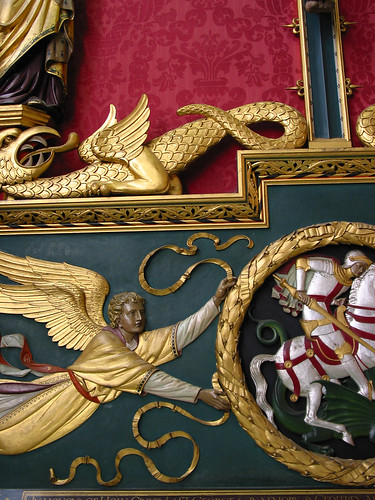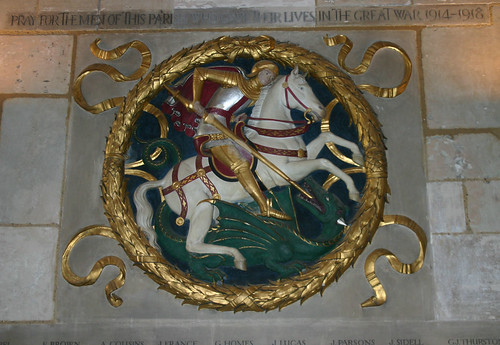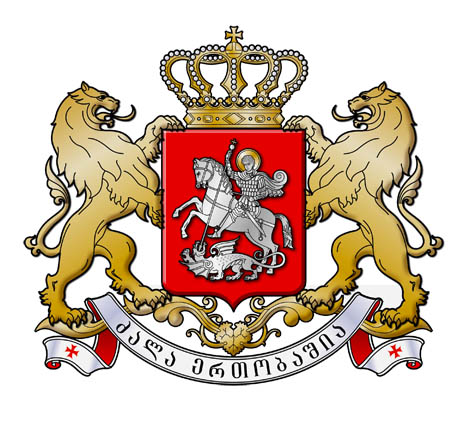Monday, April 23
A Grab Bag of Goodies for St. George's Day

Okay, so maybe he didn't slay the dragon, was from Turkey rather than England, and a spurious late account of his four martyrdoms got condemned as tgo weird for words, but St. George's true fame lies in his selfless act of martyrdom by which he slew the old serpent in defense of that fair maiden the Church. Even if some of the details are hazy, he did exist--and the fact that such extravagant glories were credibly pinned on him by later generations says something about his strength of character. (cf. "Chuck Norris has already been to Mars; that's why there are no signs of life there.") And heck, he kicks butt. We need more macho saints like that.
The late, fairy-tale addition of the dragon to his otherwise factual life still I think still has a place in the Church's heart. We need our ecclesiastical bed-time stories the same way we need Franklin's electrical key or Washington's cherry-tree. They serve as shorthand for the larger virtues that so dominated their lives.
Two years back I did my own rendition of the George-and-Dragon tale, which is worth re-reading, not only for its own sake but for its brief and pointless digression on Gibbon's theory that the saint was actually a Cappadocian bacon-salesman, a reference to the bearded lady of hagiography, and a number of jokes hinging on the shifting meaning of debonair from the Middle Ages to the present.
You think I'm kidding.
A more conventional and sober account can be found here at the Catholic Encyclopedia, which does well to separate fact from fiction, the spoilsports. But they do agree he does exist!
***
I do hope everyone wore their "Kiss Me, I'm English" buttons.
***
The charming eclecticist and brilliant liturgical planner Sir Ninian Comper produced the splendid reredos at the top of this post, and the War Memorial for Southwark Cathedral shown below. You can't get much more English than Comper, but his work freely blended Northern German influences, the art of the Renaissance, and even the classical clarity of late Roman North Africa. Of course, even the medieval English works he drew upon, as he took great pains to point out, were the result of a cosmopolitan culture of foreign exchange that few people can grasp today.

Certainly the crusaders who fought under the banner of St. George are the textbook case we all know about, but it was an age of far more travel and resettlement than we realize: Anselmo d'Aosta became Anselm of Canterbury; the Irish St. Colman died in Austria; everyone converged on the University of Paris like a Scholastic Woodstock; and royal bridges and grooms got shuttled back and forth with the result that the later Capetians could number St. Vladimir among their ancestors and even today there's a possibility that Queen Elizabeth II is descended in some small way from Mohammed. Indeed, today's globalism is rather boringly predictable by comparison.
***
Everyone loves George. Even the Muslims, somewhat curiously, associate al-Khidr (literally, the Green), a companion of Moses in the Koran who may also be the Green Knight of Arthurian legend, with the much-venerated Mar Girgis, our man George, and hundreds of Muslims frequent St. George's shrine at Beit Jala, also said to be the site of the Prophet Elijah's tomb. Due to the saint's miraculous cures, it functioned in past centuries as a sort of interfaith madhouse.

St. George is also on the coat of arms of the Republic of Georgia, and the Georgian Orthodox Church commemorates the saint twice yearly, with his feast on November 23 having been instituted by the girl missionary St. Nino Equal-to-the-Apostles (sometimes transliterated as Nina or, less felicitously, Ninny), the daughter of a Roman general, the niece of Patriarch Houbnal I of Jerusalem, and a relative of George himself. These things do tend to run in families, as anyone who's spent an afternoon with Louis and Zelie Martin can attest to.
***
On a lighter note, anyone remember Basil Fawlty's impression of his lady wife making toast?
Basil: Good old Saint George, eh Major?
Major: Hmmmm?
Basil: He killed a hideous firebreathing old dragon, didn't he?
Polly: Ran it through with a lance, I believe.
Major: But why did he kill it?
Basil: I don't know, Major, better then marrying it.
***
In terms of Great Ominous Warnings in literature, Dracula can't be beat. While Bram Stoker places St. George's Eve on May 4 rather than yesterday, he nonetheless gives us a doozie flat up in Chapter 1 tied to that very holiday. Apparently, local Transylvanian superstition makes it an über-Walpurgisnacht of sorts, though I don't know enough to distinguish folkways from literary license in this case:
"It is the eve of St. George's Day. Do you not know that tonight, when the clock strikes midnight, all the evil things in the world will have full sway? Do you know where you are going, and what you are going to?" [The inkeeper's wife] was in such evident distress that I tried to comfort her, but without effect. Finally, she went down on her knees and implored me not to go; at least to wait a day or two before starting.Ay. Happy St. George's Day! Enjoy that long, dark walk home. Muahahahaha!












